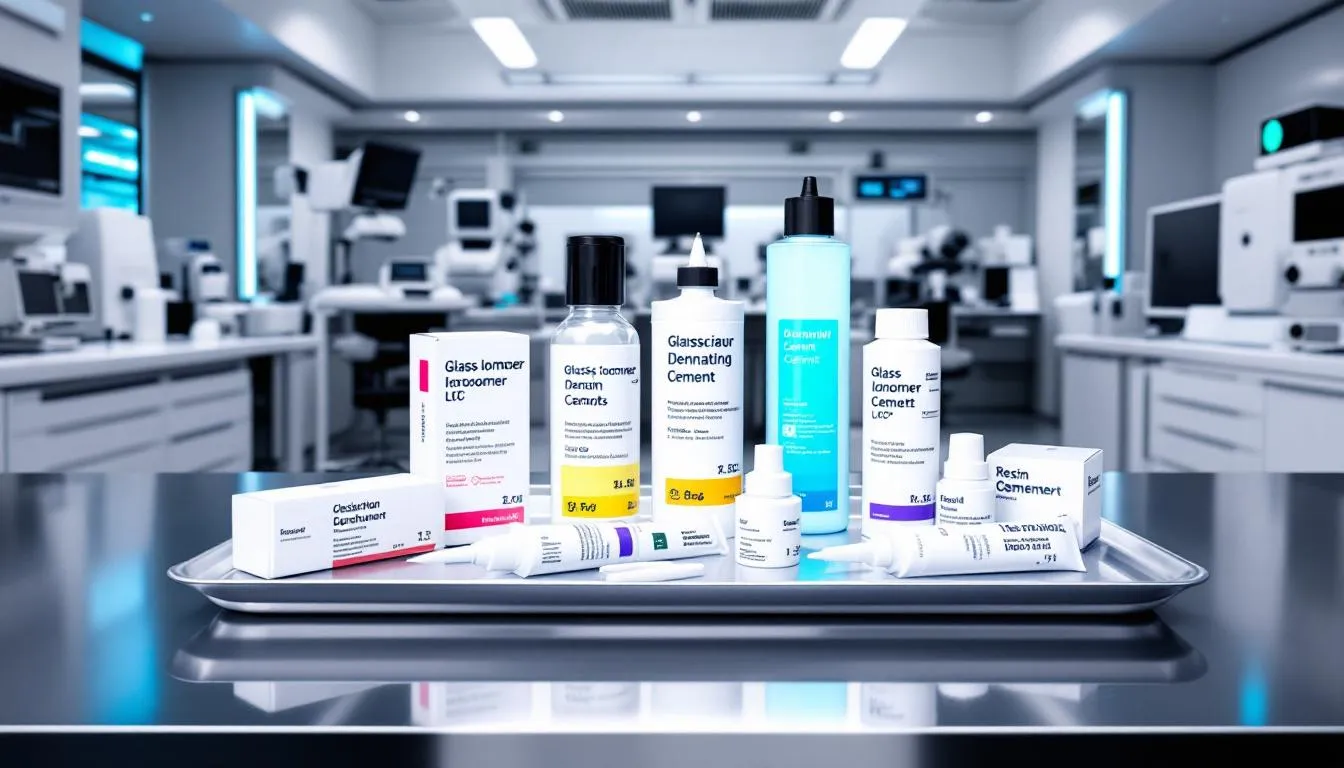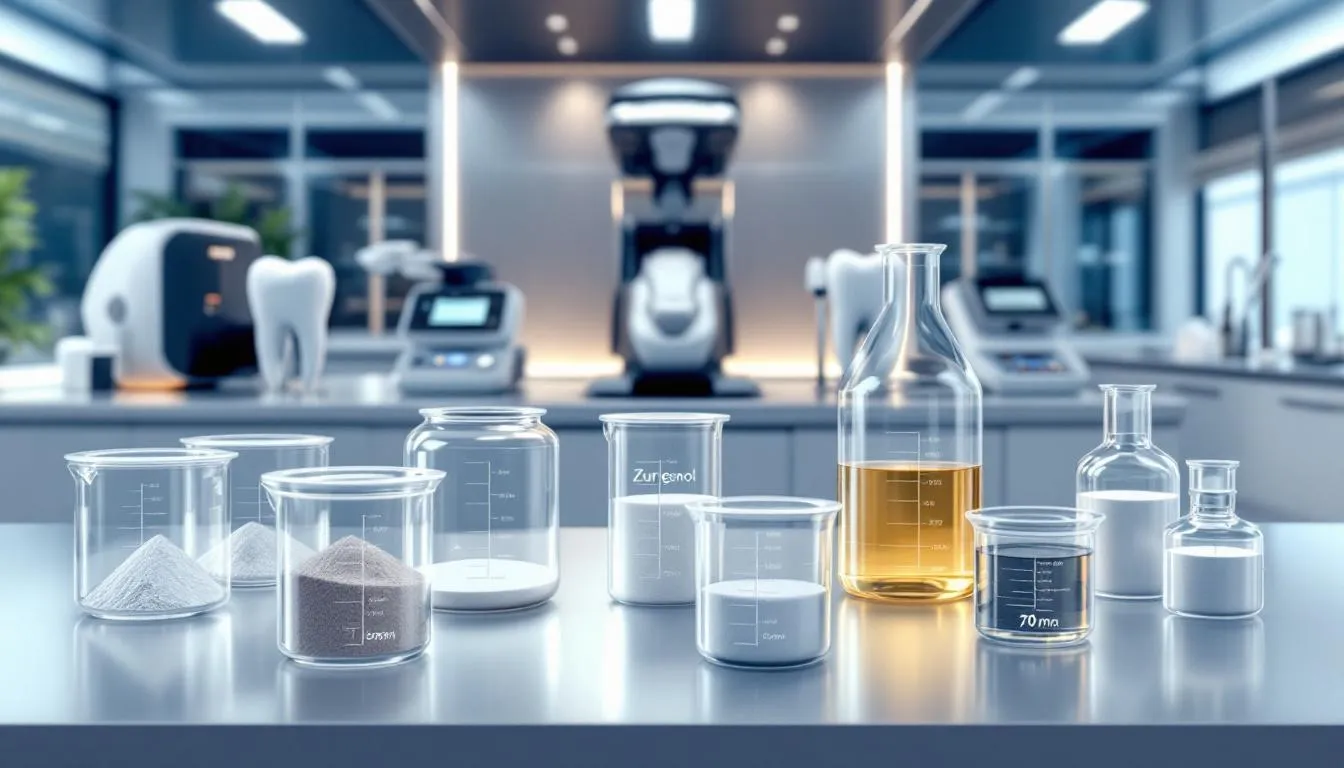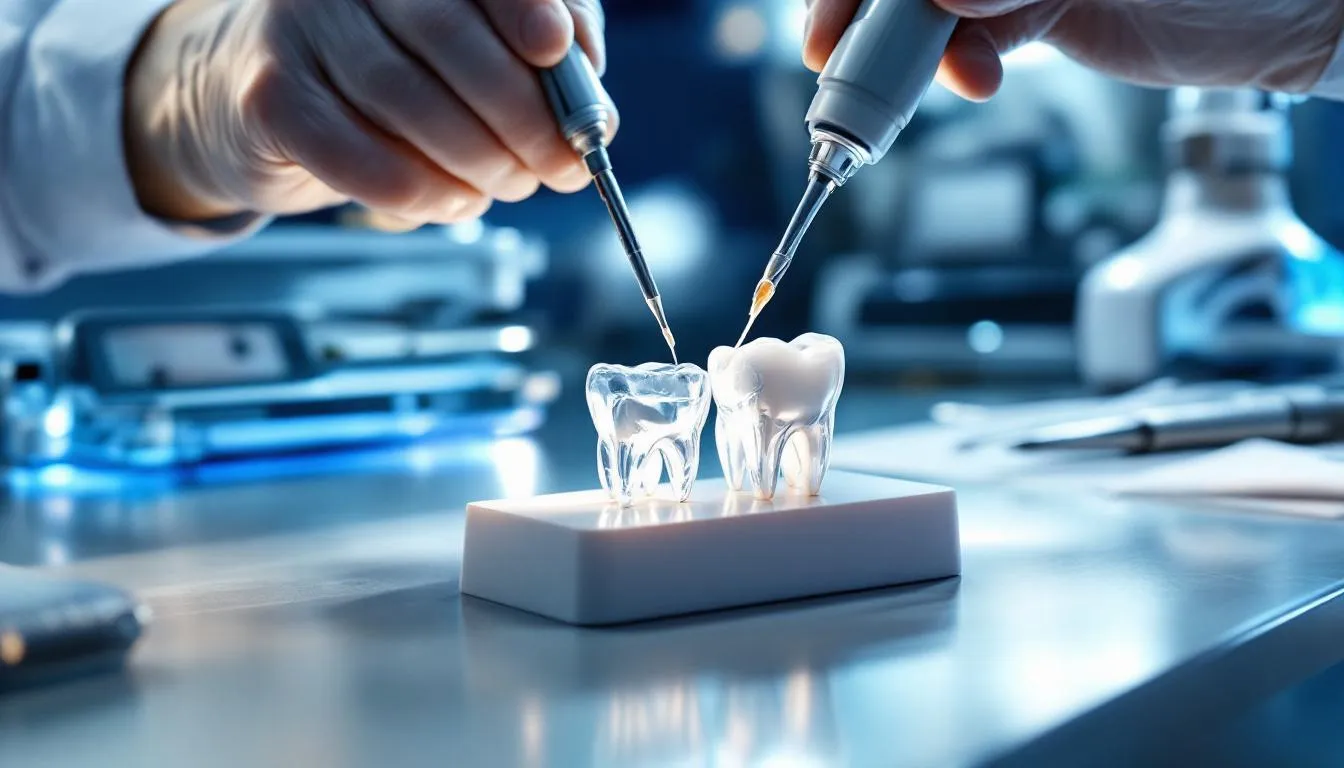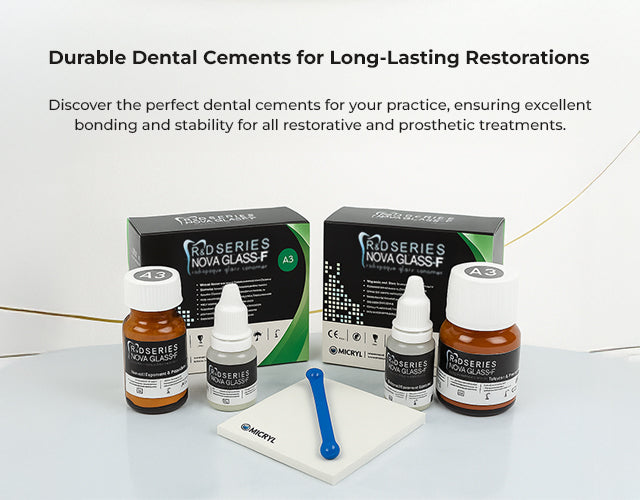Dental cement is a critical material in dentistry, used for bonding restorations, cavity liners, and temporary fixes. This article will explore the different types of dental cement, their uses, and how to choose the right one for your needs.
Key Takeaways
-
Dental cements are classified into permanent and temporary types, with specific applications enhancing dental health outcomes.
-
Effective dental cements share characteristics such as high tensile strength, minimal film thickness, and biocompatibility, crucial for optimal bonding and durability.
-
Recent innovations in dental cements, including self-adhesive and bioactive options, aim to improve application processes and support tissue regeneration.
Understanding Dental Cement

Dental cements serve multiple purposes in dentistry, from bonding restorations and cavity liners to temporary restorations. Typically, dental cement is prepared by mixing a powder with water to form a viscous liquid. The first dental cement was developed to connect prostheses to teeth and act as a pulp-protecting agent.
Knowing the various types of dental cements and their specific applications leads to optimal dental health outcomes.
Types of Dental Cements
Dental cements are broadly classified into two main types: permanent and temporary. Zinc phosphate cement, often used as a luting agent for indirect restorations, does not chemically bond to teeth. Glass ionomer cements, on the other hand, provide a chemical bond to tooth structure and release fluoride, which is beneficial for dental health.
Choosing the appropriate type of dental cement ensures the success of dental procedures, as advised by a dental professional.
Temporary Dental Cement
Zinc oxide eugenol is a temporary dental cement that is oil-based. It is primarily utilized in the field of dentistry. Known for its soothing properties on the dental pulp, it is available in powder and liquid forms or as a two-paste system.
Depending on the formulation, zinc oxide eugenol can be used for both temporary and permanent applications.
Permanent Dental Cement
Choosing the right dental cement requires knowing the specific requirements of the procedure and the type of restoration used. Permanent cement dental cements are used to secure restorations such as crowns, bridges, and inlays to the teeth.
Popular types of permanent dental cements include resin-based cements and glass ionomer cements, each with unique properties and uses.
Key Components of Dental Cements

Dental cements must possess a combination of strength, durability, and biocompatibility to function effectively in restorative procedures. They serve to secure prosthetic devices like crowns and bridges to the tooth structure while also offering pulp protection. Effective dental cements should have high tensile strength, minimal film thickness, and should not irritate the dental pulp.
Proper handling characteristics, including optimal working time and setting time, facilitate ease of use during procedures.
Zinc Oxide Eugenol
Zinc oxide eugenol is often chosen for its soothing properties, making it particularly effective for temporary dental applications. It is favored for its ability to calm the dental pulp during temporary procedures.
Zinc Phosphate Cement
Zinc phosphate cement is composed of powder (zinc oxide) and liquid (phosphoric acid). It is mixed by hand on a chilled glass slab to control its temperature and working time.
Polycarboxylate Cement
Zinc polycarboxylate cement is composed of two main components. These include a powder form, which is zinc oxide, and a liquid, which is an aqueous solution of polyacrylic acid. It was the first dental cement to chemically bond to the tooth surface and was created in the late 1960s.
Its primary use is for the permanent cementation of crown crowns, bridges, and other dental prostheses.
Glass Ionomer Cement (GIC)
The main components of glass ionomer cement include basic glass (sodium aluminosilicate) and an acidic water-soluble powder. It forms a chemical bond with dentine. It also adheres to enamel without requiring any additives. A key benefit is its ability to store and release fluoride, helping to reduce cavities.
Resin-modified glass ionomer cement combines traditional properties with resin to offer high strength and low solubility.
Resin-Based Cements
Resin-based cements mainly consist of a resin matrix. Additionally, they contain filler or fine inorganic particles, which make up 20-80% of the cement. They are available in various forms including a two-paste system, powder and liquid, or capsules. Stock resin cement is also a common choice in dental applications.
Resin cements exhibit the best compressive strength compared to other types of dental cements.
Ideal Characteristics of Dental Cements
Effective bonding and long-lasting results depend on proper application techniques for dental cements. Dental cements should exhibit properties such as high tensile strength, minimal film thickness, and should not irritate the dental pulp.
Biocompatibility
Biocompatibility in dental cements minimizes the risk of adverse reactions in patients. Glass ionomer cements are well-regarded for their fluoride release and biocompatibility, making them suitable for various applications.
Adhesion and Strength
Strong adhesion and high compressive strength are necessary for dental cements to ensure durability and retention of dental restorations. Resin cements are considered the strongest type of dental cement available, making them ideal for permanent bonding of crowns and bridges.
Aesthetics
Aesthetic qualities are important in dental cements, particularly for visible restorations, to match the natural appearance of teeth. Resin-based cements are often preferred for their superior aesthetic qualities and ability to bond with ceramic materials.
Choosing the Best Dental Cement for Your Needs

Issues like poor organization, improper material selection, and inadequate surface preparation can cause errors during the cementation process. Careful cement selection and application can mitigate common problems like insufficient bonding, excess cement, and cement washout.
Factors to Consider
Many types of dental cements are suited for specific dental procedures, with key characteristics influencing the selection process.
Bond failure often occurs because of insufficient surface treatment, inappropriate material choices, or environmental factors affecting cement properties.
Popular Options
Most permanent cementation procedures utilize GIC, RMGIC, and resin cements. Resin cements are often favored for their adhesive properties, particularly for aesthetic restorations.
Application Techniques for Dental Cements

Mix dental cements according to the manufacturer’s guidelines to achieve the correct consistency; improper mixing can lead to poor performance.
Apply dental cements using appropriate tools and techniques to ensure even coating on surfaces, which enhances adhesion and effectiveness.
Mixing and Preparation
Combining the powder and liquid components in the correct proportions ensures optimal properties in dental cements and their composition. The cement should appear smooth, void-free, and contain a workable viscosity to facilitate application and ensure effective adhesion.
Application Methods
Different application techniques can be used depending on the type of dental cement and the specific procedure being performed. Various methods exist for applying dental cements, including direct application to tooth surfaces and using applicator tools, with some cements applied directly to tooth surfaces.
Setting and Curing
The setting process of dental cements varies, with some types requiring light-cured activation while others cure chemically. The curing time for dental cements can vary, often requiring specific light sources for resin-based options to ensure proper hardening.
Common Issues and Troubleshooting
Problems with dental cements often involve issues like improper setting, pulpal irritation, and bond failures. Sensitivity issues can arise from improper fitting crowns or inadequate dentin protection.
Pulpal Irritation
Certain dental cements, particularly those containing eugenol, can lead to pulpal irritation and should be used with caution. Using cements as indicated and considering alternatives when necessary can mitigate the risk of pulpal irritation.
Bond Failures
Common reasons for bond failures include moisture contamination and inadequate surface preparation. Using the right adhesive materials and following manufacturer instructions significantly improves bond reliability and chemical adhesion.
Excess Cement Removal
Effective removal of excess cement is crucial and can be aided by using a tack-cure method to facilitate easier clean-up. A scaler tool can effectively assist in removing excess cement after the cementation process.
Innovations in Dental Cements

Recent enhancements in dental cements include self-adhesive resin cements from Kerr that streamline application processes.
Glass ionomer cement is notable for its ability to release fluoride, which helps in preventing tooth decay.
Self-Adhesive Resin Cements
Self-adhesive resin cements don’t require an additional bonding agent to adhere to tooth structures. The benefits include reduced chair time for the dentist and improved patient comfort due to their ease of use.
Bioactive Cements
Bioactive cements have been designed to facilitate healing by promoting tissue regeneration and mineralization. Some bioactive cements, such as:
-
Ceramir®
-
TheraCem® have unique properties that:
-
enhance retention
-
support tooth enamel health.
Nanotechnology in Cements
Nanotechnology is being used to improve the mechanical and physical characteristics of dental cements, particularly through the addition of nano-sized fillers. The application of nanotechnology in dental cements aims to enhance their durability and resistance to wear over time.
Heading
As we have navigated through the world of dental cements, it’s clear that the right choice and application can make a significant difference in dental procedures. With ongoing innovations and a deep understanding of each type’s characteristics, dental professionals can ensure effective and long-lasting results.
Let’s now summarize the key points and conclude our comprehensive guide.
Summary
In conclusion, choosing the right dental cement is crucial for the success of dental restorations. From understanding the different types to recognizing the importance of proper application techniques, each step plays a vital role. Innovations like self-adhesive resin cements and bioactive cements are revolutionizing the field, offering better outcomes and patient comfort. Stay informed and make the best choice to ensure the longevity and effectiveness of dental procedures.




1 comment
A very informative and insightful read. The way the topic is explained makes it easy to understand and truly adds value for readers.
Leave a comment